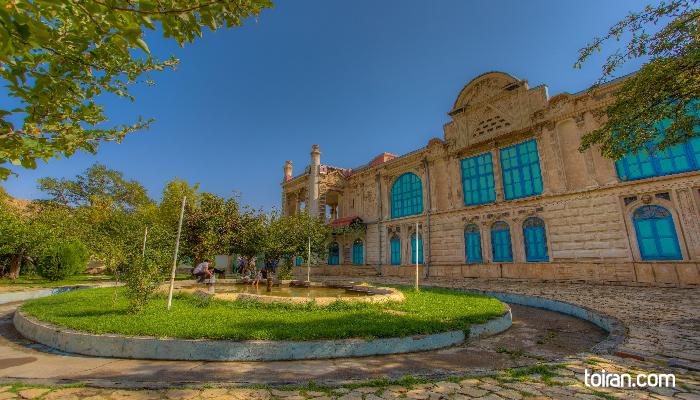Located in rural community named Baghcheh Joogh, which in the Armenian language means ‘village,’ the palace is 6 kilometers from the city of Maku. Built by Eqbal al-Saltaneh Makuyi, one of Qajar King Mozaffar ad-Din Shah’s (1853-1907) commanders and the governor of Maku, the structure is located inside an 11-hectare garden.
Built in two stories, Baghcheh Joogh Palace has a combination of traditional Persian, European and 19th century Russian architecture. The stucco reliefs, mirror work and stained glass decorations of the palace are the work of skilled Iranian artists.
Baghcheh Joogh is a symmetrical structure which is divided into a Persian half and a European half. The Persian half of the palace has floral motifs and the images of Qajar era (1785-1925) men and women. The European half of the structure has Russian wallpaper with European motifs.
The Howz Khaneh (pool house) is the heart of the house around which everything else seems to have been built. The Howz Khaneh has elaborate stucco reliefs and mirror work decorations and leads to a waiting room.
The dining room is located on the first floor. Half of the ceiling of this room has painted pictures of Persian dishes like Kebab and rice and Qajar men and the other half features paintings of European food, flowers, candles and European men.
A double staircase on the first floor leads to the office, bedrooms and Shahneshins (living rooms) on the second floor. Both staircases have stone statues. All rooms and halls on the second floor are furnished with chairs, sofas, tables and desks made by European craftsmen.
Baghcheh Joogh Palace has many other priceless possessions including embossed velvet wallpaper, brocade curtains, fine china, cut-glass chandeliers and beds with featherbed mattresses. It is said that the glass windows of the palace are made with a special non-chemical-based material that acts as an insect repellant.
The façade of the building has various stucco statues and decorative stucco fencing. Another one of the attractions of the palace is the Stone Structure or the kitchen area which has been built using smooth and carved stones. The courtyard is covered in flowers and fruit and ornamental trees and has a large pool with water streams that run in different directions.
Eqbal al-Saltaneh’s family continued to live in this palace until 1975. Following renovations, Baghcheh Joogh Palace was turned into a museum in 1986 and now showcases the personal belongings of Eqbal al-Saltaneh including the first gramophone brought to Iran which has a 60 cm horn. Baghcheh Joogh Palace was registered as a National Heritage Site in 1997.




